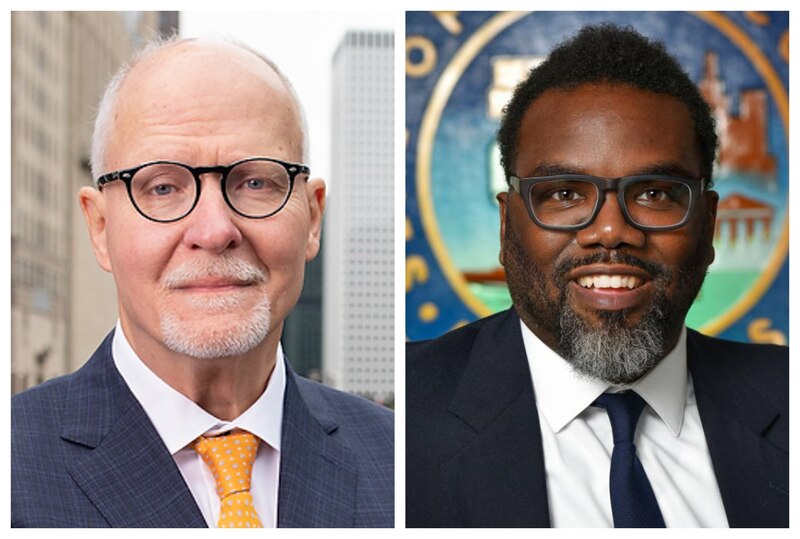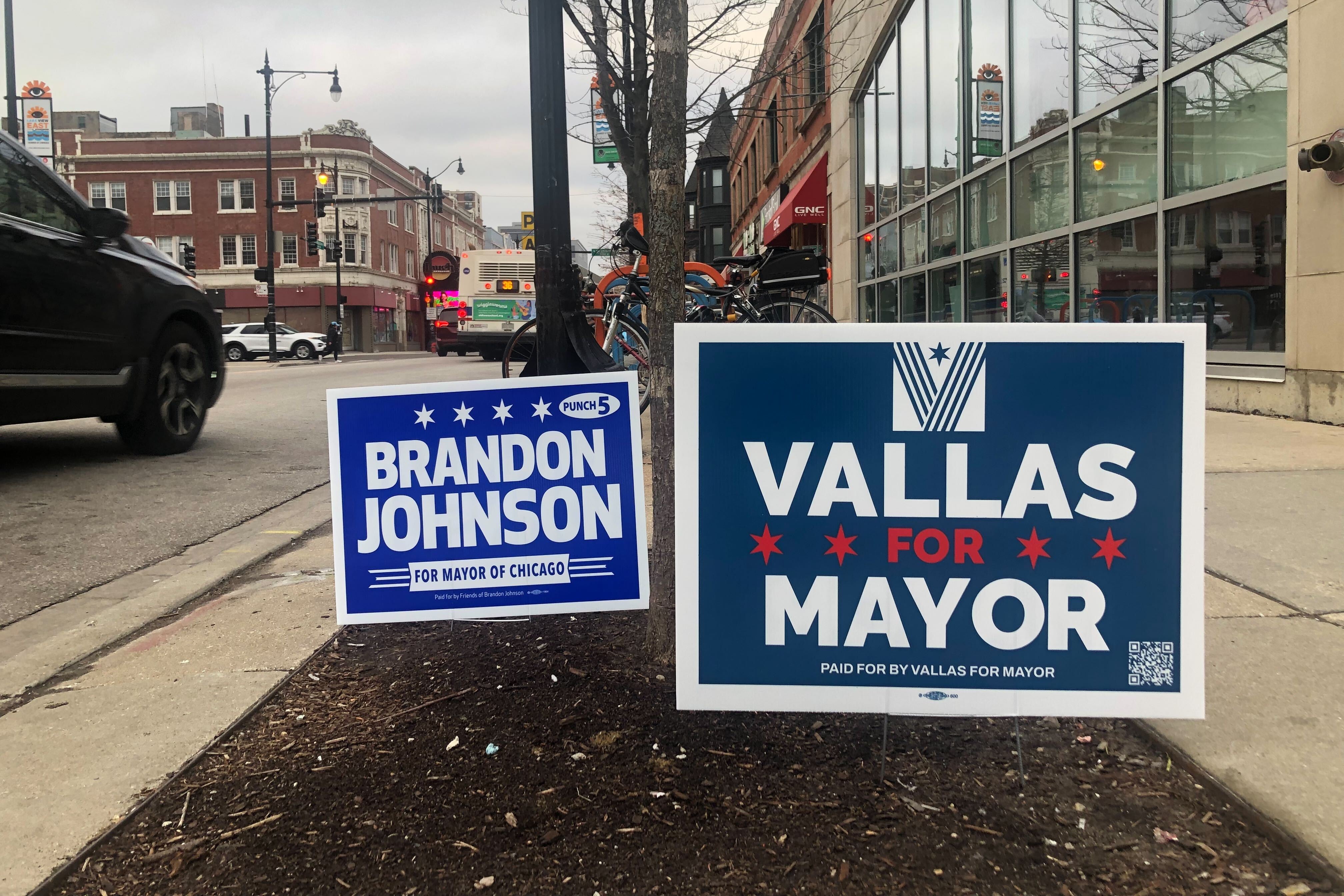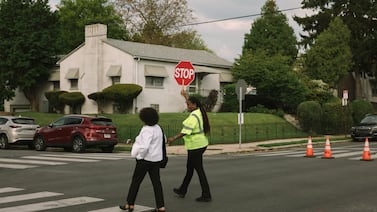Chicago voters will head to the polls once again on April 4 to vote for a new mayor, choosing between two candidates who are vastly different when it comes to public education.
Brandon Johnson is an organizer with the Chicago Teachers Union and Paul Vallas is the former CEO of Chicago Public Schools. Both are Democrats, but their views vary widely on everything from school choice to measuring academic performance to how campuses are funded.
Whoever wins will take office in late May and will get to appoint a school district CEO and seven school board members to oversee the nation’s fourth largest school district, its $9.5 billion budget, 635 schools, and the education of 322,000 children. They will also be the last mayor to have control of Chicago Public Schools before the district transitions to being governed by an elected school board.
Chalkbeat Chicago asked candidates 10 important questions about the city’s public schools in January — some of which came directly from our readers. Explore Johnson and Vallas’ answers below.
- Chicago Public Schools is no longer the nation’s third largest school district after a decade of enrollment decline. The loss of students has had significant impacts on neighborhood high schools in particular. How will you address declining enrollment?
- What are your plans to address learning loss and social emotional gaps that have emerged during the past three years of the COVID pandemic?
- The Chicago Board of Education will expand from 7 appointed members to 21 elected officials over the next four years. How will you ensure parents, students, and teachers are fairly represented on the new school board? And how will you work with the elected board?
- The Chicago Teachers Union’s contract ends next year. There was an 11-day strike in 2019, a rocky return to in-person learning in 2021, and five days of canceled classes in January 2022. How do you plan to avoid a strike in the next contract negotiation with CTU?
- Chicago Public Schools stopped rating schools and holding students back during the pandemic. Both accountability policies are under review. How do you think schools should be measured, judged, or rated?
- What are your thoughts about Chicago Public Schools’ student-based budgeting model, which ties a school’s funding to how many students are enrolled?
- The Illinois legislature created a tax-credit scholarship program in 2017 to expand school choice. After a one-year extension, the program is scheduled to sunset in 2025. Do you support continuing the state’s tax-credit scholarship program? Why or why not?
- During the early days of the pandemic, students with disabilities had limited or no access to academic accommodations written in their Individualized Education Program. Many students were unable to receive or renew IEPs to meet their needs. What will you do to ensure that students with disabilities are being identified without delay and getting the resources they need to catch up in school?
- Are you for or against trade/vocational education? How would you reactivate trade school curriculum and would it be available in all schools?
- Describe a high quality school. (How many staff work there? What are students taught? What programs or extracurriculars are offered? What support services are available? What does the facility look like? What is the schedule?) How many CPS schools meet your definition of a high quality school?

Chicago Public Schools is no longer the nation’s third largest school district after a decade of enrollment decline. The loss of students has had significant impacts on neighborhood high schools in particular. How will you address declining enrollment?
JOHNSON: If you recall, that decade began in 2013 with the greatest closure of Black and Latinx schools in Chicago’s history. If we can build sustainable community schools alongside quality affordable housing, we will reverse the trend. We must also tackle the violence epidemic with more holistic measures that provide resources and trauma intervention for students and families.
Mayors Rahm Emanuel and Lori Lightfoot have both presided over precipitous declines in pre-kindergarten enrollment. This is not simply a result of demographic change, but the district moving to an online, centralized application process for preschool that is elitist and prejudiced against families with little access to technology. Enrollment also decreases due to poor program design. This is also evident in a number of special education crises – from State monitor to transportation – over the last 10 years.
Schools communities need direct investment, guarantees of staffing and program offerings. Every school should have a library and librarian, adequate clinicians and counselors, thriving arts offerings and sports programs and teams. And the mayor of Chicago has an obligation to be actively fighting in partnership for the revenue required to fulfill those basic needs for every school in the city, not just some.
VALLAS: Making the schools more attractive to parents by allowing for schools to take on specialties as well as bring back the work study program for high school students. We must also make our schools safe, so students feel comfortable in their learning environment. We must also have the dollars make it down to the school level, right now only 60% of the budget makes it to the schools. In my career I have worked to make education meaningful to students allowing a greater trust in the system by not only the students but also their parents. I would also expand the alternative schools network to provide for the educational needs for high school students too old for the traditional high school program.
Reader question. What are your plans to address learning loss and social emotional gaps that have emerged during the past three years of the COVID pandemic?
JOHNSON: Let’s remember that students and families are still struggling with the pandemic, and there is much trauma and recovery that must occur – especially among Black and Brown students and families who make up the majority of CPS students (like my own).
First, we must address the trauma that existed pre-pandemic, and acknowledge that COVID-19 exposed and exacerbated conditions around cleanliness, bilingual education, access to technology, special education services and more, that city leaders left unaddressed for decades. Asking a student to catch up on math when they are still recovering from the death of a loved one, or a classmate, is inhumane.
Students and families must have trauma support, such as weekly cognitive behavioral therapy, and students need summer jobs and engaging programming. Support student and staff mental health by infusing schools with mental health professionals like counselors and clinicians so that unaddressed trauma is acknowledged, and treated, and learning is more of the focus from day to day. Teachers and staff need adequate time and professional development to help address student needs. And educators need to be empowered with planning time to reinvigorate curriculum and work with students to ensure instructional practices and pedagogy meet students’ needs and interests.
VALLAS: The loss of learning due to the COVID pandemic has been unprecedented. We must work to ensure that our children catch up and can be competitive in their future. In order to meet the gap our children are facing I will open all school buildings through the dinner hour, weekends and summers. We need to invite community organizations to provide enrichment to students in the CPS during these off hours as well as invite retired CPS Teachers to provide tutoring and academic support to the students.
The Chicago Board of Education will expand from seven appointed members to 21 elected officials over the next four years. How will you ensure parents, students, and teachers are fairly represented on the new school board? And how will you work with the elected board?
JOHNSON: I support a map that ensures all communities in this tremendously diverse city have the opportunity to have their voices heard. This is why I worked so closely with Illinois Senate President Don Harmon and community organizations on the legislation to create this vibrant model of democracy for the first time ever in the history of Chicago Public Schools.
We need campaign finance rules to prevent those with no stake in our public schools, or our communities, from controlling our democracy. We cannot have uber rich, arch-conservatives usurping the power that working people in Chicago fought so hard to win. We need candidates who are deeply invested and knowledgeable from the communities served to have a fair chance to win races to influence the education of their children.
Democratic governance requires partnership. The city doesn’t absolve itself of any responsibility to schools just because there are democratically elected school community leaders sitting at the Board of Education. As mayor, I will continue to fight for resources in our schools, and maintain and build upon the coordinated support and services that the city has to offer children and families.
VALLAS: Like I have done all my career I will work with the elected board of education with the respect that is due to them as an equally elected official that is representing the needs of the community that elected them. In all CPS work I will put the needs of the students first and advocated with the board for any necessary resources. Before this board takes office it is important that they do not inherit a broken system, I will push the dollars to the school level and ensure that schools have the resources they need.
Reader question. The Chicago Teachers Union’s contract ends next year. There was an 11-day strike in 2019, a rocky return to in-person learning in 2021, and five days of canceled classes in January 2022. How do you plan to avoid a strike in the next contract negotiation with CTU?
JOHNSON: We need a mayor who can reasonably work with labor. We cannot have the type of leader who will promise something like, say, an elected representative school board and then fight tooth and nail to stop it from being enacted. We cannot have a mayor who, on the campaign trail, calls for a nurse and social worker in every school, then puts teachers on strike for two weeks when they ask for exactly that in writing. We cannot have a mayor who grants expanded parental leave to city workers, but blocks educators from receiving the same.
Just a shift in consistency and keeping one’s word will more than allow for a much more rational and collaborative process.
As mayor, I will be a partner in working with Chicago Public Schools and the Chicago Teachers Union to remove obstacles in the way of achieving excellent schools, rather than contributing to constant friction. The stakes are too high for our students and families for labor and leadership not to have a positive working relationship. And I will openly advocate and build coalitions to identify revenue sources and structures that, over time, will deliver the fully funded schools that families and communities deserve.
VALLAS: The previous CTU strike could have been avoided and we see the cost of that strike in the already exacerbated loss of learning from the pandemic. Over the course of my career I have negotiated 6 teacher contracts with teachers unions in the largest district in 4 different states that led to no strikes and members getting a pay raise. If all parties work in good faith there should be no need for a teacher strike this year which only leads to a greater negative impact of the education on Chicago’s children who are already struggling to regain confidence in the classroom.
Chicago Public Schools stopped rating schools and holding students back during the pandemic. Both accountability policies are under review. How do you think schools should be measured, judged, or rated?
JOHNSON: We cannot continue to punish schools that have suffered from decades of divestment, violence and destabilization. When a school struggles, we often give them more accountability, yet fewer resources. So any school rating formula must bring greater equity, and greater support, to ensure greater success.
Chicago Public Schools does not need its own rating structure, as the state still has and requires one. CPS’ time is better spent identifying sources of revenue to fill the gaps identified in programs, staffing, and services that we know hold schools back from meeting student needs and increasing enrollment. I live in Austin. My wife and I drive two children to Portage Park and another to Hyde Park every day because there are few schools in our community to meet their extracurricular needs. Families should not have to leave their community to find a school with a music program, a sports program, a nurse in every school, or a library with a librarian. We have to use what we already know about the strengths, weaknesses, and assets in our schools to ensure that we are directing resources to where they are needed to make every school excellent.
VALLAS: We should aspire for high standards, we cannot embrace the bigotry of soft expectations. We must set high standards, we have to measure school’s base on their improvement as a school. We must take every school uniquely and see their growth from where they were to where they are.
Reader question. What are your thoughts about Chicago Public Schools’ student-based budgeting model, which ties a school’s funding to how many students are enrolled?
JOHNSON: Student-based budgeting (SBB) and the former SQRP rating policy have had a devastating impact on our schools. SBB, in particular, has contributed to principals whose budgets are strapped to choose between keeping a veteran teacher or having a librarian and a functioning library. Schools struggling with enrollment need to have a process by which root causes are identified and resources are deployed to ensure students still have the richest possible education, and the school has an opportunity to grow its enrollment.
The state, in its evidence-based funding model, has recognized that student and community needs must drive school funding, and that all districts must be brought up to a certain level of resources to meet those needs. Yet CPS has not adopted that approach among its schools. We cannot keep supporting a system that favors choice, but does not provide schools with the same baseline resources and offerings – then punishes students who attend the less frequently chosen school.
VALLAS: The first priority is to push the funding down to the schools. We have to have the majority of the funding flow down to the local schools as of right now only 60% of the funds makes it to the local schools. My second priority is to make sure that the money that is allocated to the students encompasses the needs of the student, we need to make sure the school district is allocating Title I money directly to the school it is assigned too. This money needs to flow directly to the school with only minimal diversions because unfortunately funding due to poverty has been used as discretionary funds by the administration.
Reader question. The Illinois legislature created a tax-credit scholarship program in 2017 to expand school choice. After a one-year extension, the program is scheduled to sunset in 2025. Do you support continuing the state’s tax-credit scholarship program? Why or why not?
JOHNSON: I do not, because this is the kind of thinking that continues to reinforce unequal educational opportunities. Until every Chicago public school and big-city public school has the baseline of resources provided in suburban districts with high property tax bases, the idea of “choice” is a fallacy.
Parents with resources are able to navigate the system for their students, which I don’t begrudge. What is concerning is that families without the means, time, resources, and access to navigating these same systems have no choice at all.
I am not interested in continuing to shift unequal resources around. I am interested in leveling the playing field for all families.
VALLAS: The tax credit scholarship program is beneficial in empowering parents to pick the school that best suits their child’s needs. Whether the students attend private, parochial, public or public charter schools they are students of the City and we need to ensure quality education regardless of their zip code.
During the early days of the pandemic, students with disabilities had limited or no access to academic accommodations written in their Individualized Education Program. Many students were unable to receive or renew IEPs to meet their needs. What will you do to ensure that students with disabilities are being identified without delay and getting the resources they need to catch up in school?
JOHNSON: Teachers in Seattle last fall ratified a contract with a three adult (two teachers, one instructional assistant) to 10 student ratio to help address the needs of their special education population. Chicago must work toward something similar to address compensatory services and the particular needs of this incredibly vulnerable student population. We also need greater clinical support to properly diagnose and service the individualized education programs of these students. This includes the need to ramp up pipelines with state and local funding to hire many more teachers, special education classroom assistants, and teacher assistants to address the accumulated needs of students living with disabilities.
VALLAS: Students with disabilities are a priority even much more so after the loss of learning experienced due to the pandemic. The key to supporting these students is the availability of resources at the local school level. My administration will reallocate dollars in a way that the schools see the most benefit and allow principals to support all the students in their neighborhood schools.
Reader question. Are you for or against trade/vocational education? How would you reactivate trade school curriculum and would it be available in all schools?
JOHNSON: We need to do much better to train Chicagoans to fill the jobs that exist today. Businesses are hiring and manufacturers are hiring. There may be somewhere around 30,000 unfilled manufacturing jobs across the state, and a good number of them are here in Chicago. But we’ve abandoned vocational training in our schools. Modern manufacturing jobs require tech skills, and it is our job to give our students the skills necessary to succeed. So I am all for trade and vocational education, commonly known as Career and Technical Education (CTE), in Chicago Public Schools. CTE is essential to closing the gap between our district, and skilled trade industries and employers.
There is potential in some of the plans the district and CPS CEO Pedro Martinez have around this. With an aviator simulator in Dunbar, and making Tilden, Phillips, Chicago Vocational, and Fenger sustainable community schools with specialized and relevant trades training, we will have education and apprenticeship pipelines to create the skills and engagement necessary for a CTE corridor that will empower our Black and Latinx students to become the next generation of unionized trade workers.
VALLAS: Yes I support trade and vocational education. However I believe on a broader scale that we need to integrate a work study program into all of our high schools and make elective programs more meaningful. We need to reestablish our VocEd and occupational training programs that were in our high schools during my time at the CPS. My administration will do this by partnering with local trade unions and businesses in our city. We have to leverage these connections in ways that attract our students to take interest in these programs that offer amazing opportunities for success after high school.
Describe a high-quality school. (How many staff work there? What are students taught? What programs or extracurriculars are offered? What support services are available? What does the facility look like? What is the schedule?) How many CPS schools meet your definition of a high-quality school?
JOHNSON: We have a model that works – the Sustainable Community School (SCS) model, which calls for collaborative and effective strategy for increasing educational equity. SCS builds on the traditional community school model to prioritize specific pillars and principles to make schools the anchors of their communities, and to share leadership around meeting student, family, educator, staff, and community needs.
We also have schools that have parent mentors, community programming, and partnerships to provide additional support for mental and physical health across the district. Neighborhood schools like Kelly High, National Teachers Academy, Hanson Park Elementary (despite a horrendous facility situation), Chavez Elementary, Beidler Elementary are all vibrant school communities using culturally relevant curriculum and community partnerships to advance the academic and social/emotional needs of countless children. However, we need to do more and better. That will require greater investments in addressing the needs of homeless children, students with disabilities and all the newcomers who do not speak English as their primary language. It also cannot continue to be the case that selective enrollment schools, which provide students with the most extensive course offerings, extracurriculars and sports opportunities, serve only the wealthiest students in the system.
VALLAS: A high quality is a medium sized neighborhood school that embraces high standards and offers the students a high quality curriculum that ensures students achieve a high level of proficiency in all core areas. The ideal quality school offers key enrichment opportunities in the academic year as well as continuing into the non-traditional school hours (weekends, evenings, summers and holidays) to support students in their growth. My ideal quality school offers key wrap-around services for students to ensure they are holistically growing. This school also needs a well trained and supported local school council that broadly represents the community and can provide a vehicle for community input in school governance and supplemental activities.
Becky Vevea is the bureau chief for Chalkbeat Chicago. Contact Becky at bvevea@chalkbeat.org.






